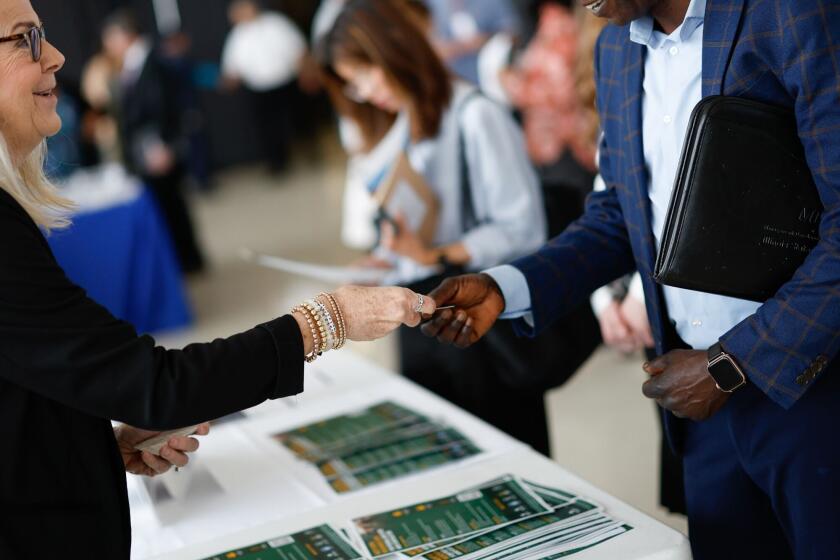Economic Growth Surges; Inflation Is Held in Check
- Share via
WASHINGTON — The nation’s economy surged anew during the first three months of this year, despite the Asian economic slump, the government reported Thursday, but inflation remained solidly in check, easing fears that the Federal Reserve will raise interest rates soon.
President Clinton, hailing the news at his press conference, said that he was “encouraged by the underlying fundamentals” of the economy and dismissed suggestions that the economic boom and accompanying stock-market surge are a dangerous “bubble” that could soon burst.
“I’m pleased with the success of the market,” the president said.
Preliminary estimates by the Commerce Department showed that the real gross domestic product--the nation’s total economic output--rose at an annual rate of 4.2% from January to March, up from a 3.7% pace during the final three months of 1997.
But a closely watched Labor Department index that measures labor costs indicated that wages and employee benefits actually rose more slowly during the first quarter, despite the current tight labor market.
As a result, analysts said, the Federal Reserve is less likely to raise interest rates when its top policymakers next meet on May 19, despite their decision last month to be ready to raise rates again if inflation pressures continued.
The encouraging new figures set off a rally in the nation’s financial markets. The Dow Jones industrial average soared by 111.85 points over the day to close at 9,063.37. Bond prices staged their biggest rally in six months.
Dana Johnson, an analyst for First Chicago Corp., said that the new batch of figures takes the pressure off the central bank and gives the Federal Reserve “more leeway to be patient and watch and wait” rather than rushing to raise rates.
Robert G. Dederick, economist and chief Fed watcher for the Northern Trust Co. of Chicago, agreed. “Today’s report will keep Fed policymakers on alert, but it’s unlikely to galvanize them into action.”
The report on the gross domestic product showed the remarkable U.S. economic boom continuing unabated--at a far faster rate than had been expected--with momentum strong in virtually every sector of the economy.
The unusually strong growth came despite falling exports to Asia because of the economic slump there that in turn exerted a drag on the U.S. economy.
U.S. consumer spending in the first quarter was especially buoyant, surging at an annual rate of 5.7%, up from a 2.5% pace during the final three months of 1997. Domestic demand grew at a strong 5.9% annual pace.
At the same time, business investment in new equipment bounded ahead at a 28.8% annual rate after hardly changing in the previous quarter. Residential construction rose at a robust 17.6% annual rate, partly because the El Nino weather pattern made much of the nation warmer than usual.
But it was the good performance on the inflation front that provided the greatest surprise. Despite the tight labor market, the Labor Department’s employment cost index rose only 0.7% during the first quarter of this year--down from a 1% rise in the previous period.
The index now stands 3.1% above its level of a year ago.
One of the Federal Reserve’s major fears has been that the labor shortage now spreading across the economy would raise pressure for wage increases, eventually leading to a new round of inflation that ultimately could threaten the current economic boom.
Thursday’s statistics, however, showed that wages and salaries actually rose more slowly in the first quarter than they had during the final three months of 1997, while the costs of providing fringe benefits rose only half as much as in the October-December period.
Moreover, the GDP inflation index, considered the broadest measure of price trends in the economy, rose at a minuscule annual rate of 0.9%--down from a 1.4% pace in the two previous quarters and its lowest level in almost 35 years.
To add to the good news, many economists believe that the economy’s growth rate already has begun to slow somewhat, possibly enough to ease it into the average 2.5%-a-year range that policymakers say is ideal to avert a new round of inflation.
Dean Baker, an analyst at the Economic Policy Institute, pointed out that many of the factors that led to the surge in growth during the first three months of the year--such as El Nino--no longer are present.
And economists said that some components of the first-quarter surge, such as a nationwide boom in home building and continued inventory building by businesses, are by nature unlikely to be sustained for very long.
Indeed, Robert Parry, president of the Federal Reserve Bank of San Francisco, said that the economy already had begun to moderate since March 31, when policymakers at the central bank decided to brace themselves for a possible interest-rate hike if the boom continued for very much longer.
“There have been some developments since that meeting we had in March that are significant,” Parry told reporters after delivering a speech in Phoenix. “The economy has slowed,” and the threat of renewed inflation has been reduced.
Thursday’s spurt in stock prices effectively offset a 146-point drop that the market took Monday after reports that Fed policymakers were prepared to raise interest rates if the economy did not slow.
More to Read
Inside the business of entertainment
The Wide Shot brings you news, analysis and insights on everything from streaming wars to production — and what it all means for the future.
You may occasionally receive promotional content from the Los Angeles Times.










